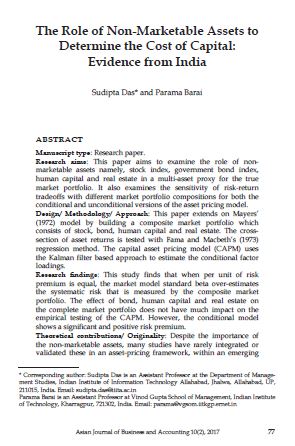The Role of Non-Marketable Assets to Determine the Cost of Capital: Evidence from India
Main Article Content
Abstract
Manuscript type: Research paper.
Research aims: This paper aims to examine the role of nonmarketable
assets namely, stock index, government bond index,
human capital and real estate in a multi-asset proxy for the true
market portfolio. It also examines the sensitivity of risk-return
tradeoffs with different market portfolio compositions for both the
conditional and unconditional versions of the asset pricing model.
Design/ Methodology/ Approach: This paper extends on Mayers’
(1972) model by building a composite market portfolio which
consists of stock, bond, human capital and real estate. The crosssection
of asset returns is tested with Fama and Macbeth’s (1973)
regression method. The capital asset pricing model (CAPM) uses
the Kalman filter based approach to estimate the conditional factor
loadings.
Research findings: This study finds that when per unit of risk
premium is equal, the market model standard beta over-estimates
the systematic risk that is measured by the composite market
portfolio. The effect of bond, human capital and real estate on
the complete market portfolio does not have much impact on the
empirical testing of the CAPM. However, the conditional model
shows a significant and positive risk premium.
Theoretical contributions/ Originality: Despite the importance of
the non-marketable assets, many studies have rarely integrated or
validated these in an asset-pricing framework, within an emerging market. Thus, the present study seeks to advance the theoretical and
empirical understanding of the role of non-marketable assets in the
composition of market proxies for an asset pricing model, in India.
Practitioner/ Policy implications: The validity of the CAPM is insensitive
to the inclusion of non-marketable assets in the market portfolio.
This implies that investors use prior belief and conditioning
variables as predictive variables to determine the cost of capital. The
outcome of this study provides academics and practitioners a better
understanding of the cross-sectional behaviour of stock returns in the
Indian market.
Research limitation: The limited work done on the Indian capital
market coupled by the limited availability of non-marketable data in
this study, may constrain the comparison of the results. In addition,
the outcome drawn from this study cannot be generalised on other
emerging markets as the focus of this study was only on the Indian
capital market.
Keywords: Fama-MacBeth Regression, Kalman Filter, Mayers CAPM,
Non-marketable Assets.
JEL Classification: G12, G31
